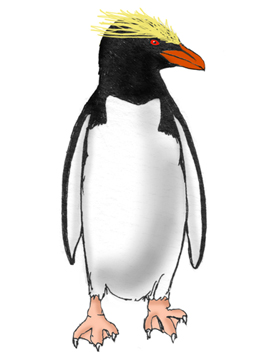

They are found around the Antarctic Circle, the Antarctic Peninsula and in the South Atlantic and southern Indian Oceans.
They live mostly in the ocean when not breeding. While breeding, they gather in a large colony on rocky ground, and sometimes in clumps of grass to lay eggs.
They are 2.25 feet tall and weigh up to 9 pounds. They have a black face with yellow-orange feather crests off the back of their heads. Their back, head, chin, and upper chest are black. Their chest, belly, and under wings are white. They have a large, orange bill and red eyes. They have pinkish legs and feet.
They seem to spend all their time, when not breeding, out in the ocean diving for tiny shrimp like animals called krill.
They eat mostly krill and some fish.
They walk a long way over land to reach their nest site. They call out to find their mate from the year before. Their call is how they find their own mate. They keep the same mate for many years. They have a courtship dance where they swing their heads from side to side. They build a nest by scraping a dent in the ground and line it with small stones or bits of grass. The female lays two eggs, though only one will survive. Both male and female share warming the eggs (incubation). When the babies hatch, the parents take turns guarding them while the other parent goes to the ocean to feed and brings back food for the young.
Related Activites:
Penguin (Macaroni) Coloring Page
Kingdom: Animalia
Phylum: Chordata
Subphylum: Vetebrata
Class: Aves
Order: Sphenisciformes
Family: Spheniscidae
Genus: Eudyptes
Species: E. chrysolophus
When you research information you must cite the reference. Citing for websites is different from citing from books, magazines and periodicals. The style of citing shown here is from the MLA Style Citations (Modern Language Association).
When citing a WEBSITE the general format is as follows.
Author Last Name, First Name(s). "Title: Subtitle of Part of Web Page, if appropriate." Title: Subtitle: Section of Page if appropriate. Sponsoring/Publishing Agency, If Given. Additional significant descriptive information. Date of Electronic Publication or other Date, such as Last Updated. Day Month Year of access < URL >.
Amsel, Sheri. "Penguin (Macaroni)" Exploring Nature Educational Resource ©2005-2024. December 13, 2024
< http://www.exploringnature.org/db/view/Penguin-Macaroni >

